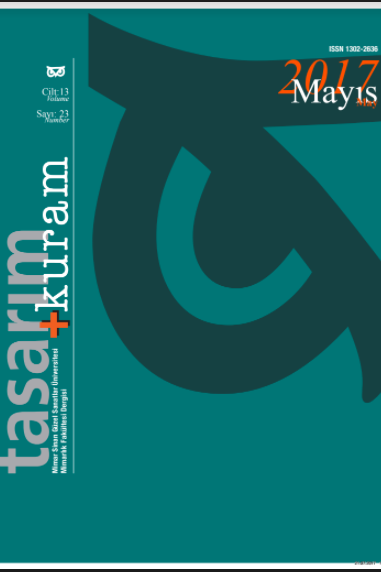Tüketime Bağlı Bir Kimlik Öğesi Olarak Konut ve Planlama Açısından Bir Değerlendirme
Günümüzde konut üretiminde, kamu müdahalesinden çok piyasada üretimi belirleyen süreç ve koşulların etkili olduğu, giderek kamunun da piyasadaki aktörler gibi davranmaya başladığı görülmektedir. Türkiye’nin serbest piyasa ekonomisine geçmesiyle gelir dağılımı giderek bozulmaya başlamış, küresel ölçekte izlenebilen eğilimlere de uygun şekilde, lüks tüketime yönelen bir kitle ortaya çıkmıştır. Konut, artık bir yatırım aracı olduğu kadar, toplumsal statüyü de simgeleyen bir tüketim malı haline gelmiştir. Temel insan gereksinimlerinden olan konuta bu yaklaşım, planlama alanı açısından bazı sorun alanlarını gündeme getirmektedir. Barınma amacı ile tüm gelir grupları için yeterli ve erişilebilir konut alanları planlaması yaklaşımının yetersizlik gösterdiği, piyasa süreçleri içinde kentin çeperlerine yerleşerek kentin yayılmasında belirleyici olan yeni kapalı sitelerin oluşturulduğu görülmektedir. Bu yaklaşım, kent planlamanın doğası ile çelişmektedir. Makalenin amacı, mevcut konutlaşma eğilimleri içinden kapalı sitelerin tüketim toplumu açısından tartışılması ve bu tür konutlaşmanın kent planlama disiplini açısından değerlendirilmesidir. Tartışma, İstanbul kentinin konut üretim dinamikleri ile örneklenecektir.
Anahtar Kelimeler:
Tüketim toplumu, kapalı siteler, konutlaşma, yaşam tarzı, sosyal ayrışma
Housing as a part of identity in the consumerist society and an assesment in the frame of urban planning
Private sector investments are the leading factor of housing production today while public agents become a part of the housing market, instead of controlling it. A new consumerist segment in the society has emerged in Turkey after the transition to free market economy, in line with the global tendencies. Luxury housing became an instrument for investment as well as a sign of social status of the inhabitants. Housing production, which is a human right, without public control leads to problems in the field of urban planning. On the one hand, there is a shortage of affordable housing production, on the other development of gated communities surround periphery of the cities. Not only gated communities but also housing development projects in inner cities became the commodities of free market, which constitutes a contradiction with the nature of the planning. The aim of this article is to discuss the gated communities, which epitomize commodified housing production in the frame of consumer society, referring to Istanbul.
Keywords:
Consumerist society, gated communities, housing, life style, social segregation,
___
- Atkinson, R. 2006. Padding the Bunker: Strategies of Middle-class Disaffiliation and Colonisation in the City. Urban Studies, Vol. 43, No. 4, pp. 819-832
- Atkinson R, Blandy S, Flint J, Lister D. 2004. Gated Cities of Today: Barricaded Residential Development in England. Gated Communities: Building Social Division or Safer Communities?. 18-19 September 2003, Glasgow.
- Bali, R. N. 2002. Tarz-ı Hayat’tan Life Style’a -Yeni Seçkinler, Yeni Mekanlar, Yeni Yaflamlar. İstanbul: İletiflim Yayınları
- Barthes, Roland. 1998. Çağdafl Söylenler. çev. Tahsin Yücel. İstanbul: Metis Yayınları
- Baudrillard, J. 2004. Tüketim Toplumu. çev. H. Deliçaylı, F. Keskin. İstanbul:.Ayrıntı Yay.
- Blakely, E. J; Snyder, M. G. 1999. Fortress America, Gated Communities in the United States, Washington D.C: Brookings Institution Press
- Bourdieu, P. 1995. Pratik Nedenler. İstanbul: Kesit Yayıncılık
- Davis, M. 1992. City of Quartz. New York: Vintage Books,
- Ekici, T. 2011. Sürdürülebilir Kentsel Geliflme Çerçevesinde Kapalı Sitelerin İrdelenmesi: İstanbul Çekmeköy Örneği. yayınlanmamıfl Yüksek Lisans Tezi, Mimar Sinan Güzel Sanatlar Üniversitesi, FBE, İstanbul.
- Erkip, F. 2010. Community and neighborhood relations in Ankara: An urban-suburban contrast. Cities, 27 (2010) pp. 96-102
- Firidin Özgür, Ebru. 2006. Sosyal ve Mekansal Ayrıflma Çerçevesinde Yeni Konutlaflma Eğilimleri: Kapalı Siteler, İstanbul, Çekmeköy Örneği. yayımlanmamıfl doktora tezi, Mimar Sinan Güzel Sanatlar Üniversitesi, FBE, İstanbul.
- Firidin Özgür, Ebru. 2011. Konut Alanlarında Güncel Eğilimler ve Mahalle Olgusu. TOL, güz 2010- bahar 2011, Kayseri MO Yayını, ss.16-24.
- Giglia, A. 2003. Gated Communities in Mexico City. Gated Communities: Building Social Division or Safer Communities?, 18-19 September 2003, Glasgow.
- Gooblar, A. 2002. Outside the Walls: Urban Gated Communities and their Regulation within the British Planning System.European Planning Studies, Vol. 10, No. 3, pp. 321-334.
- Grant, J. 2003. Planning responses to gated communities in Canada. Gated communities: building social division or safer communities?, 18-19 September 2003, Glasgow.
- http://www.bristol.ac.uk/sps/cnrpapersword/gated/grant.doc, 20.09.2004.
- Harvey, David. 2001. Spaces of Capital, New York: Routledge
- Iflık, O, Pınarcıoğlu, M. 2003. Nöbetlefle Yoksulluk: Gecekondulaflma ve Kent Yoksulları: Sultanbeyli Örneği. İstanbul: İletiflim
- İBB, fiehir Planlama Müdürlüğü. 2009. 1/100000 Ölçekli İstanbul Çevre Düzeni Planı Raporu.
- Keyder, Çağlar. 2000. Enformel Konut Piyasasından Küresel Konut Piyasasına. İstanbul Küresel ve Yerel Arasında içinde: Ç. Keyder, der. İstanbul: Metis. ss. 171-191,
- Le Goix, R. 2003. Gated Communities Sprawl in Southern California and Social Segregation. Gated com munities: building social division or safer com munities? 18-19 September 2003. Glasgow
- Low, S. 2004. Behind the Gates, Routledge
- Öncü, Ayfle. 1999. ‘İdealinizdeki Ev’ Mitolojisi Kültürel Sınırları Aflarak İstanbul’a Ulafltı. Birikim. 123, temmuz 1999, ss. 26-46
- TOKİ url, (eriflim tarihi 29.07. 2012):
- http://www.toki.gov.tr/programlar/ihale/c_illist.asp?x_ilko du=34
- Wu, F. 2003. Rediscovering the ‘gate’ under market transi tion: from work-unit compounds to commodity housing enclaves, Gated Communities: Building Social Division or Safer Communities?
- 19 September 2003, Glasgow.
- ISSN: 1302-2636
- Başlangıç: 1999
- Yayıncı: Mimar Sinan Güzel Sanatlar Üniversitesi
Sayıdaki Diğer Makaleler
Tüketime Bağlı Bir Kimlik Öğesi Olarak Konut ve Planlama Açısından Bir Değerlendirme
Mimari Üretimde Kullanım ve(ya) Katılım
Güldehan Fatma ATAY, Ataman DEMİR
Ofis İç Mekan Tasarımlarında Gelişen Teknolojiler ışığnda Esneklik
Hande Zeynep ALTINOK KAYAN, Didem TUNCEL
Profesör Kemal Ahmet Aru; Mimarlık Eğitimi içinde şehircilik ve şehircilik Eğitiminde Geleceğe Bakış
Kemal Ahmet Aru “Hoca”: Bazı Anılar ve Bir Görüşme
Kemal Ahmet Arû ve Misyon Kuşağı
Örnek bir Prestij Konut Alanı olarak Levent Mahallesi
